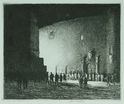
19th, 20th & 21st Century Fine Prints
707-546-7352 · fax 707-546-7924 · web: www.annexgalleries.com · email: artannex@aol.com
Herman Webster Biography
Herman Webster
American
1878–1970
Biography
Herman Armour Webster was born in New York City on April 6, 1878. His father, George Huntington Webster was a partner in the New York division of the Armour business interests of Chicago; and it was as a sign of appreciation and respect that he named his child after his benefactors..Herman studied at The Sheffield Scientific School at Yale University Class of 1900, where he edited and contributed illustrations to campus humor magazine The Yale Record. After graduating he sailed to Europe to attend the 1900 Universal Exposition in Paris.
While in Paris, he took art lessons from Alphonse Mucha. Over the next two years Webster would reside in Paris; contend with a bout of typhoid fever in Berlin trek the Russian steppes on the Tans-Siberian Railway. He continued on to the Orient, visiting Beijing, Nagasaki, Yokohama, and Tokyo; and ultimately return home via the Pacific. He reached Chicago just before Christmas, 1901, and revealed to his family a desire to pursue the artist’s life in Paris. Webster's family was opposed to his career choice. Webster, however, would return to Paris in 1904, after spending two years unsuccessfully pursuing a business career in America.
Upon his return to Paris, Webster enrolled at the Academie Julian, where he studied with Jean-Paul Laurens the Paris academician and professor at the Ecole des Beaux Arts. It was there that Webster met Donald Shaw MacLaughlan, a Canadian artist already established as a significant presence in the Paris art scene, and it was he who first taught Webster the craft of etching. It is said that Webster first became interested in etching after viewing a portfolio of prints made by the visionary French artist Charles Meryon and would also have known of the work of James Abbott McNeill Whistler, the American artist whose masterful prints captivated generations of young graphic artists. Webster studied further with Eugene Bejot, a French printmaker whose views of Paris and the Seine depicted the spirit of Paris during the Belle Epoque.
In 1905, Webster submitted three etchings at the Salon de La Societe Nationale des Beaux Arts, which were accepted, and he was noticed as a rising talent. He followed these with tours of Europe with Donald Shaw MacLaughlan. Upon his return to Paris, Webster established himself in a studio on the Rue de Furstenberg. His reputation grew quickly with the issuance of additional prints, and in 1907 Webster was made an Associate of The Royal Society of Painter-Etchers in London, as well as memberships in both the Société Nationale des Beaux-Arts and the American National Academy of Design.. In 1915 Webster was awarded the Gold medal at The Panama-Pacific Exposition in San Francisco for his etchings.
In 1910, Webster visited New York City, where he was impressed by the skyscrapers he saw, a building type unknown in Europe. He stayed long enough to make a series of drawings and at least one etching that captured the changing shape and structure of the city, and arranged for representation with the New York publisher and dealer Frederick Keppel & Company.
In 1914 Webster enlisted in the American Ambulance Corps in support of the Allied Forces during World War I, and served through 1917, when he was exposed to militarized gas. His eyesight was severely impaired forcing him to abandon the close, detailed work of etching in favor of watercolor and ink wash painting for a period of nearly ten years. Ironically, his watercolors from this period, and especially those made during his travels to Venice, are some of the most beautiful ever produced with their evocative fluidity and economy of means. For his service to the nation of France, Webster was awarded the Croix de Guerre and made a Chevalier (later an Officer) of The National Order of The Legion of Honor in 1926.
Herman Armour Webster died in Paris, France on March 9, 1970.

